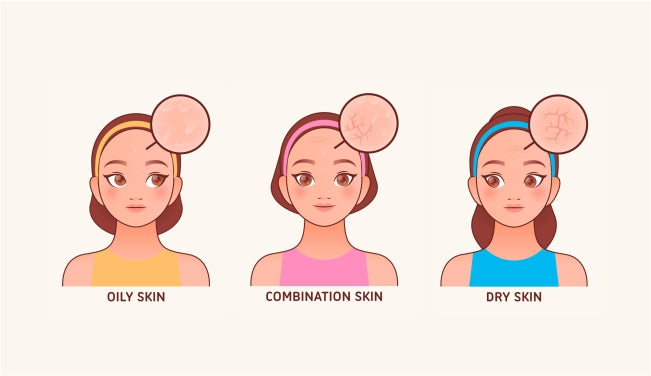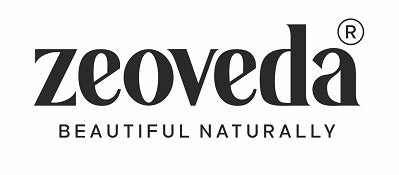
Do You Know How To Identify Your Skin Type?
Share
It is a very common confusion when you enter your teenage that what is my skin type and how can can I identify it. There are lots of content on the internet regarding the identification of the skin type but after reading this blog all your confusion will be put to rest. Let's dive into the details :
The American Academy of Dermatology (AAD) classifies skin into five different types. These 5 types are - oily, dry, normal, combination, and sensitive skin.
Each skin type has its own set of distinct characteristics and needs that can influence the appearance and feel of your skin.
Understanding your skin type first allows you to make informed decisions. It will provide your skin with the customized care and protection it requires now and in the future.
If you are unsure of your skin type. Below, we will go over the fundamentals of identifying your skin type.
Common Features Of Each Skin Type

Your skin, as the largest organ in your body, performs a variety of important and complex functions, such as regulating your body temperature and protecting you from germs. This applies particularly to the outermost layer of your skin, known as the skin barrier.
This protective barrier, which is primarily composed of lipids (such as ceramides), serves as the primary gatekeeper between your skin and the external environment, keeping water in and harmful substances out.
Although a healthy skin barrier is essential for all skin types, it is also important to remember that each individual's skin is unique in many ways. This means that there is no "one size fits all" approach to achieving radiant, healthy-looking skin. However, there are a few unifying characteristics to look for that can help you answer the question, "What is my skin type?"
Here are the main indicators to consider:
Oily Skin
An overproduction of sebum leads to oily skin, resulting in a shiny and greasy appearance, specifically in the T-zone (forehead, nose, and chin). According to the American Academy of Dermatology (AAD), oily skin may have fewer wrinkles but more prone to enlarged pores, acne, blackheads, and whiteheads.

Keep in mind that having oily skin does not necessarily mean that your skin requires less moisture than other skin types. Oily skin can be helped by using products that nourish and hydrate without clogging your pores or causing breakouts. A gentle, foaming cleanser that effectively removes dirt, excess oil, and other impurities is essential for oily skin. It should also include a lightweight, oil-free, non-comedogenic moisturizer to give your moisturizer the hydration it requires.
Dry Skin
Dry skin produces fewer elastics and natural oils than other skin types. This may give it a dull, abrasive, flaky, or even scaly appearance. It frequently feels tight or less elastic, is noticeably dehydrated, and may exhibit more visible fine lines. Itchy or irritated skin may occur. Ceramides, for example, should be included in a dry skin skincare routine because they help maintain the skin's protective moisture barrier.

The Mayo Clinic recommends following proper skincare routine and avoiding excessively long, hot showers, moisturizing multiple times per day, and using fragrance-free, non-comedogenic, and alcohol-free skincare products for dry skin types.
Normal Skin
Skin that is balanced, not too dry or oily, is said to be normal. It doesn't feel tight or greasy, flake, or breakout easily. Small pores, a smooth skin texture, and a lower propensity for sensitivity characterize normal skin.
Normal skin doesn't have any particular problems or concerns, but it still needs the right skincare to look and feel its best. By retaining moisture and supporting your skin's barrier defenses, the ideal normal skin care routine keeps your skin moisturized.
Combined Skin Combination skin is skin that is both dry and oily in some areas.
Combination Skin

Combination skin is skin that is both dry and oily in some areas. The T-zone (forehead, nose, and chin) is typically oily, whereas the cheeks can be dry. To care for combination skin, use products that address both the oily and dry areas.
A gentle cleanser, a light moisturizer for dry areas, and a mattifying product or oil-free moisturizer for oily areas should all be part of a daily skincare routine. Using a toner and exfoliating on a regular basis can also aid in skin balance.
Sensitive Skin
Although it's frequently referred to as a skin type, sensitive skin can also be oily, dry, or normal in texture. Whatever skin type you have, if you have sensitive skin, it may appear red and feel dry, itchy, or burning. These symptoms may be brought on by certain substances, such as dyes, and environmental factors and may be related to having skin that is more sensitive to external irritants.
If you have sensitive skin, you might be able to pinpoint the ingredients that are the root of your problem and steer clear of products that contain them. Altering your surroundings will lessen your exposure to irritants in the kitchen, bathroom, or other places where they can set off an allergic reaction.
How To Identify Your Skin Type
If descriptions of the various skin types didn't help you decide, there are several tests you can do at home to help you identify your skin type. These two techniques can help identify your skin type:
The Wait and Watch Method
● First, Wash your face with water and dry it with care.
● 30-minute wait
● You probably have oily skin if it looks shiny all over.
● You may have dry skin if it is scaly, feels tight, or both.
● If your T-zone is the only area that shines, you most likely have combination skin.
● You probably have normal skin if it feels hydrated, comfortable, and non-oily.
The Blotting Sheet Method
● Wait 30 minutes after washing your face with a mild cleanser and patting it dry.
● Hold the blotting sheets up to the light to see the oil stains after pressing the sheets to various parts of your face.
● You have oily skin if the sheets absorbed a lot of oil from every part of your face. You almost certainly have dry skin if the sheet has barely absorbed any oil.
● You have combination skin if only a small amount of T-zone oil is visible on the sheets.
● You most likely have normal skin if there is barely any oil coming from any area of your face.
Conclusion
At Zeoveda, we understand the importance of identifying your skin type and tailoring your skincare routine accordingly.
Our extensive range of products caters to all five skin types as classified by the American Academy of Dermatology (AAD): oily, dry, normal, combination, and sensitive.
From ceramides for dry skin to gentle foaming cleansers for oily skin, our products nourish and hydrate your skin without clogging your pores or causing breakouts. By identifying your skin type and using our products, you can give your skin the customized care and protection it needs for a radiant, healthy look
